Popular categories
Looking for a yarn?

53% Cotton, 33% Viscose, 14% Linen
from 3.05 $ /50g
Order DROPS Belle from Wool Warehouse Direct Ltd

|
DROPS Belle uni colour 53% Cotton, 33% Viscose, 14% Linen |
3.05 $ /50g |
Order |
Clicking the ORDER button will redirect you to Wool Warehouse Direct Ltd website
The yarn cost is calculated from the pattern’s smallest size and the yarn’s cheapest product type. Looking for an even better price? You might find it on the DROPS Deals!
Swing by Spring Top
Knitted sweater in DROPS Belle. Piece is knitted top down with round yoke, lace pattern, leaf pattern and short balloon sleeves. Size: S - XXXL
DROPS design: Pattern vs-078
Yarn group B
-------------------------------------------------------
SIZE:
S - M - L - XL - XXL – XXXL
Finished measurements:
Chest measurements: 80-88-96-106-122-132 cm = 31½"-34⅝"-37¾"-41¾"-48"-52"
Full length: 39-41-43-45-47-49 cm = 15¼"-16⅛"-17"-17¾"-18½"-19¼"
All measurements in charts are in cm.
MATERIALS:
DROPS BELLE from Garnstudio (belongs to yarn group B)
250-300-300-350-350-400 g color 02, off white
KNITTING GAUGE:
21 stitches in width and 28 rows vertically in stockinette stitch = 10 x 10 cm = 4" x 4".
NEEDLES:
DROPS DOUBLE POINTED NEEDLES SIZE 4 mm = US 6
DROPS CIRCULAR NEEDLE SIZE 4 mm = US 6: Length 40 = 16" and 60 = 24" or 80 cm = 32" for stockinette stitch.
DROPS DOUBLE POINTED NEEDLES SIZE 3 mm = US 2,5
DROPS CIRCULAR NEEDLE SIZE 3 mm = US 2,5: Length 40 cm = 16" and 80 cm = 32" for edges.
Needle size is only a suggestion! If you have too many stitches on 10 cm = 4" switch to a larger needle size. If you have too few stitches on 10 cm = 4" switch to a smaller needle size.
-------------------------------------------------------
Alternative Yarn – See how to change yarns here
Yarn Groups A to F – Use the same pattern and change the yarn here
Yarn usage using an alternative yarn – Use our yarn converter here
-------------------------------------------------------
Women Jumpers Tops T-shirtsassembly free lace leaf pattern round neck round yoke top down

53% Cotton, 33% Viscose, 14% Linen
from 3.05 $ /50g
Order DROPS Belle from Wool Warehouse Direct Ltd

|
DROPS Belle uni colour 53% Cotton, 33% Viscose, 14% Linen 3.05 $ /50g Order |
Clicking the ORDER button will redirect you to Wool Warehouse Direct Ltd website
The yarn cost is calculated from the pattern’s smallest size and the yarn’s cheapest product type. Looking for an even better price? You might find it on the DROPS Deals!
- English (US/in)
- Česky
- Dansk
- Deutsch
- Eesti keel
- English (UK/cm)
- Español
- Français
- Íslenska
- Italiano
- Magyar
- Nederlands
- Norsk
- Polski
- Português
- Suomi
- Svenska
- English (UK/cm), Bulgaria
- English (UK/cm), Croatia
- English (UK/cm), Greece
- English (UK/cm), Latvia
- English (UK/cm), Lithuania
- English (UK/cm), Romania
- English (UK/cm), Slovenia
- Česky, Slovakia
Pattern instructions
EXPLANATION FOR THE PATTERN:
-------------------------------------------------------
PATTERN:
See diagrams A.1 and A.2. Choose diagram for your size.
DECREASE TIP (applies to side of body):
Decrease 1 stitch on each side of marker thread as follows: Work until 3 stitches remain before marker thread and knit 2 together, knit 2 (marker thread is between these 2 stitches), slip 1 stitch knitwise, knit 1, pass slipped stitch over stitch worked.
BIND-OFF TIP:
To avoid a tight bind-off edge you may use a larger needle size. If this also is too tight, work a 1 yarn over after approx. every 4th stitch while binding off (bind off yarn overs as regular stitches).
-------------------------------------------------------
START THE PIECE HERE:
-------------------------------------------------------
SWEATER - SHORT OVERVIEW OF THE PIECE:
Work neck edge and yoke in the round from mid back, top down. Now divide yoke for body and sleeves. Body is worked in the round on circular needle, top down. Work sleeves in the round on double pointed needles/short circular needle, top down.
NECK EDGE:
Cast on 100-100-104-108-112-120 stitches on circular needle size 3 mm = US 2,5 with Belle. Knit 1 round.
Then work rib = knit 1/purl 1. When rib measures 2-2-3-3-3-3 cm = ¾"-¾"-1⅛"-1⅛"-1⅛"-1⅛", switch to circular needle size 4 mm = US 6.
Insert 1 marker at the beginning of round mid back, measure yoke from this marker!
YOKE:
Work A.1 in the round (= 25-25-26-27-28-30 repetitions of 4 stitches).
When A.1 has been worked, there are 200-200-208-216-280-300 stitches on needle. Piece now measures 4-4-4-4-6-6 cm = 1½"-1½"-1½"-1½"-2⅜"-2⅜" from marker.
Then work A.2 in the round (= 25-25-26-27-28-30 repetitions of 8-8-8-8-10-10 stitches). REMEMBER THE KNITTING GAUGE!
When A.2 has been worked, there are 275-300-312-351-392-420 stitches on needle. Piece measures approx. 14-14-14-17-19-19 cm = 5½"-5½"-5½"-6¾"-7½"-7½" from marker (i.e. 16-16-17-20-22-22 cm = 6¼"-6¼"-6¾"-8"-8¾"-8¾" from cast-on edge).
Work in stockinette stitch until piece measures 18-20-21-23-25-27 cm = 7"-8"-8¼"-9"-9¾"-10⅝" from marker. Now divide piece for body and sleeves. Work next round as follows:
Knit 38-42-44-50-58-63 (= ½ back piece), slip the next 62-66-68-76-80-84 stitches on a stitch holder for sleeve, cast on 8-8-12-12-12-12 new stitches on needle (= in the side under sleeve), knit 75-84-88-99-116-126 (= front piece), slip the next 62-66-68-76-80-84 stitches on a stitch holder for sleeve, cast on 8-8-12-12-12-12 new stitches on needle (= in the side under sleeve), knit the last 38-42-44-50-58-63 stitches (= ½ back piece). Finish body and sleeves separately. NOW MEASURE PIECE FROM HERE!
BODY:
= 167-184-200-223-256-276 stitches. Insert 1 marker thread in the middle of the 8-8-12-12-12-12 new stitches under each sleeve (= in the side of body). There are now 83-92-100-111-128-138 stitches on front piece and 84-92-100-112-128-138 stitches on back piece.
Move the marker threads upwards when working; they are used when decreasing in the sides later.
Work in stockinette stitch in the round.
When piece measures 3 cm = 1⅛" from division, decrease 1 stitch on each side of every marker thread - read DECREASE TIP (= 4 stitches decreased). Decrease like this every 2 cm = ¾" 4-4-4-4-5-5 times in total = 151-168-184-207-236-256 stitches.
Work in stockinette stitch in the round until piece measures 15-15-16-16-16-16 cm = 6"-6"-6¼"-6¼"-6¼"-6¼" from division – or desired length (approx. 2 cm = ¾" remain until finished measurements).
Knit 1 round while increasing 23-26-28-31-36-38 stitches evenly = 174-194-212-238-272-294 stitches.
Switch to circular needle size 3 mm = US 2,5. Work rib (knit 1/purl 1) in the round for 2 cm = ¾". Bind off with knit over knit and purl over purl - read BIND-OFF TIP.
Sweater measures approx. 39-41-43-45-47-49 cm = 15¼"-16⅛"-17"-17¾"-18½"-19¼" from shoulder and down.
SLEEVES:
Slip the 62-66-68-76-80-84 stitches from stitch holder in one side of piece on double pointed needles/a short circular needle size 4 mm = US 6, and pick up 1 stitch in each of the 8-8-12-12-12-12 new stitches cast on in the side under sleeve = 70-74-80-88-92-96 stitches. Work in stockinette stitch in the round until sleeve measures 12-11-10-8-7-5 cm = 4¾"-4⅜"-4"-3⅛"-2¾"-2" from division (approx. 5 cm = 2" remain until finished measurements, try the sweater on and work to desired length. Knit 1 round while decreasing 16-16-14-14-14-14 stitches evenly = 54-58-66-74-78-82 stitches.
Switch to double pointed needles size 3 mm = US 2,5. Work rib in the round = knit 1/purl 1 for 5 cm = 2". Bind off with knit over knit and purl over purl - remember BIND-OFF TIP!
Sleeve measures approx. 17-16-15-13-12-10 cm = 6¾"-6¼"-6"-5⅛"-4¾"-4" from division. Work the other sleeve the same way.
This pattern has been corrected. Click here to see the correction/s.
Correction in diagram A.2.
Diagram
All measurements in charts are in cm.

|
= knit |

|
= purl |

|
= work 7-7-7-9-9-9 stitches in same stitch as follows: Knit 1, but wait to drop the stitch worked off left needle, * 1 yarn over, knit 1 in same stitch *, work from *-* 3-3-3-4-4-4 times in total, drop stitch worked off the needle. |

|
= between 2 stitches make 1 yarn over, work yarn over twisted on next round to avoid large holes. |

|
= knit 2 together |

|
= slip 1 stitch knitwise, knit 1, pass slipped stitch over stitch worked |

|
= slip 2 stitches knitwise, knit 1, pass the 2 slipped stitches over stitch worked |

|
= work 3 stitches in same stitch as follows: Knit 1, but wait to drop the stitch worked off left needle, 1 yarn over, knit 1 in same stitch, drop stitch worked off the needle |




What can you do with our patterns? You can share DROPS patterns online, using the pattern original picture, materials, name and number. But you are NOT ALLOWED to reproduce the complete pattern digitally in any way. Yarn stores are welcome to use the DROPS pattern database to promote the sale of our assortment. You can print out our patterns, make as many copies as you’d like. The only thing we ask is that you don't make any changes / additions to the original printed document. And that the patterns according to the DROPS philosophy are given out to the consumers for free. Editorials that wish to publish our patterns in printed books or magazines can contact us for more information. The sale of garments based on DROPS patterns is permitted as long as they are sold as single items or per order. Further commercial use of the patterns is not permitted. It has to be clearly stated that the garment is made based on a design from DROPS DESIGN. The use of clothing labels of which DROPS DESIGN forms part is conditioned by the inclusion of the following text: “A DROPS DESIGN made by …..”. The use of DROPS photos for marketing purposes/sales is only permitted in connection with the use/sale of DROPS products. The photos may not be cut or edited and the logo should be clearly visible.
We reserve the right to withdraw the permission for use of our patterns at any time, notwithstanding the reason.
Each of our patterns has specific tutorial videos to help you.
These step-by-step tutorials might also help you:
Why is the knitting/crochet tension so important?
Knitting tension is what determines the final measurements of your work, and is usually measured per 10 x 10 cm. It is provided like so: number of stitches in width x number of rows in height - eg: 19 stitches x 26 rows = 10 x 10 cm.
The knitting tension is very individual; some people knit/crochet loosely while others work tightly. You adjust the knitting tension with the needle size, which is why the suggested needle size only serve as a guide! You need to adjust this (up or down) to ensure that YOUR knitting tension matches the knitting tension provided in the pattern. If you work with a different knitting tension than provided you will have a different yarn consumption, and your work will have different measurements than what the pattern suggests.
The knitting tension also determines which yarns can replace each other. As long as you achieve the same knitting tension you can replace one yarn with another.
See DROPS lesson: How to measure your tension/gauge
See DROPS video: How to make a gauge tension swatch
How do I know how many balls of yarn I need?
The required amount of yarn is provided in grams, eg: 450 g. To calculate how many balls you’ll need you first need to know how many grams are in 1 ball (25g, 50g or 100g). This information is available if you click on the individual yarn quality on our pages. Divide the amount required with the amount of each ball. For example, if each ball is 50g (the most common amount), the calculation will be as follows: 450 / 50 = 9 balls.
Can I use a different yarn than what the pattern suggests?
The important thing when changing from one yarn to another is that the knitting/crochet tension remains the same. This is so that the measurements of the finished piece will be the same as on the sketch provided. It is easier to achieve the same knitting tension using yarns from the same yarn group. It is also possible to work with multiple strands of a thinner yarn to achieve the knitting tension of a thicker one. Please try our yarn converter. We recommend you to always work a test swatch.
Please NOTE: when changing yarn the garment might have a different look and feel to the garment in the photo, due to individual properties and qualities of each yarn.
See DROPS lesson: Can I use a different yarn than the one mentioned in the pattern?
What are the yarn groups?
All our yarns are categorised into yarn groups (from A to F) according to thickness and knitting tension – group A contains the thinnest yarns and group F the thickest. This makes it easier for you to find alternative yarns to our patterns, should you wish to switch yarn. All yarns within the same group have a similar knitting tension and can easily replace each other. However, different yarn qualities have different structures and properties which will give the finished work a unique look and feel.
How do I use the yarn converter?
At the top of all our patterns you’ll find a link to our yarn converter, which is a helpful tool should you wish to use a different yarn than suggested. By filling in the yarn quality you wish to replace, the amount (in your size) and number of strands, the converter will present good alternative yarns with the same knitting tension. Additionally it will tell you how much you’ll require in the new qualities and whether you’ll need to work with multiple strands. Most skeins are 50g (some are 25g or 100g).
If the pattern is worked with multiple colours, every colour will have to be converted separately. Similarly, if the pattern is worked with several strands of different yarns (for example 1 strand Alpaca and 1 strand Kid-Silk) you will have to find alternatives for each, individually.
Why do you show discontinued yarns in the patterns?
Since different yarns have different qualities and textures we have chosen to keep the original yarn in our patterns. However, you can easily find options among our available qualities by using our yarn converter, or simply pick a yarn from the same yarn group.
It is possible that some retailers still have discontinued yarns in stock, or that someone has a few skeins at home that they would like to find patterns for.
The yarn converter will provide both alternative yarn as well as required amount in the new quality.
What size should I knit?
If you think it's hard to decide what size to make, it can be a good idea to measure a garment you own already and like the size of. Then you can pick the size by comparing those measures with the ones available in the pattern's size chart.
You'll find the size chart at the bottom of the pattern.
See DROPS lesson: How to read size chart
Why do I get the wrong knitting tension with the suggested needle size?
The needle size provided in the pattern serves only as a guide, the important thing is to follow the knitting tension. And since knitting tension is very individual, you will have to adjust the needle size to ensure that YOUR tension is the same as in the pattern – maybe you’ll have to adjust 1, or even 2 needle sizes, up or down to achieve the correct tension. For this, we recommend that you work test swatches.
Should you work with a different knitting tension than the one provided, the measurements of the finished garment might deviate from the measurement sketch.
See DROPS lesson: How to measure your tension/gauge
See DROPS video: How to make a gauge tension swatch
Why is the pattern worked top-down?
Working a garment top-down provides more flexibility and room for personal adjustment. For example it is easier to try the garment on while working, as well as making adjustments to length of yoke and shoulder caps.
The instructions are carefully explaining every step, in the correct order. Diagrams are adjusted to the knitting direction and are worked as usual.
How do I work according to a knitting diagram?
The diagram depicts all rows/rounds, and every stitch seen from the right side. It is read from bottom to top, from right to left. 1 square = 1 stitch.
When working back and forth, every other row is worked from the right side and every other row is worked from the wrong side. When working from the wrong side, the diagram will have to be worked reversed: from left to right, knit stitches are purled, purl stitches are knit etc.
When working in the round every round is worked from the right side and the diagram are worked from right to left on all rounds.
See DROPS lesson: How to read knitting diagrams
How do I work according to a crochet diagram?
The diagram depicts all rows/rounds, and every stitch seen from the right side. It is worked from bottom to top, from right to left.
When working back and forth every other row is worked from the right side: from right to left and every other row is worked from the wrong side: from left to right.
When working in the round, every row in the diagram are worked from the right side, from right to left.
When working a circular diagram you start in the middle and work your way outwards, counter clockwise, row by row.
The rows usually start with a given number of chain stitches (equivalent to the height of the following stitch), this will either be depicted in the diagram or explained in the pattern.
See DROPS lesson: How to read crochet diagrams
How do I work several diagrams simultaneously on the same row/round?
Instructions for working several diagrams after each other on the same row/round, will often be written like so: “work A.1, A.2, A.3 a total of 0-0-2-3-4 times". This means you work A.1 once, then A.2 is worked once, and A.3 is repeated (in width) the number of times provided for your size – in this case like so: S = 0 times, M = 0 times, L=2 times, XL= 3 times and XXL = 4 times.
The diagrams are worked as usual: begin with the first row in A.1, then work the first row in A.2 etc.
See DROPS lesson: How to read knitting diagrams
See DROPS lesson: How to read crochet diagrams
Why are the sleeves shorter in larger sizes?
The total width of the garment (from wrist-to-wrist) will be larger in the larger sizes, despite the actual sleeves being shorter. The larger sizes have longer sleeve caps and wider shoulders, so there will be a good fit in all sizes.
Where on the garment is the length measured?
The measurement sketch/schematic drawing provides information regarding the full length of the garment. If it’s a jumper or a jacket the length is measured from the highest point on the shoulder (usually closest to the neckline), and straight down to the bottom of the garment. It is NOT measured from the tip of shoulder. Similarly, the length of yoke is measured from the highest point on the shoulder and down to where yoke is split into body and sleeves.
See DROPS lesson: How to read a schematic drawing
What is a repeat?
Diagrams are often repeated on the round or in height. 1 repeat is the diagram the way it appears in the pattern. If it says to work 5 repeats of A.1 in the round, then you work A.1 a total of 5 times after/next to each other in the round. If it says to work 2 repeats of A.1 vertically/in height you work the entire diagram once, then begin again at the start and work the entire diagram one more time.
Why does the piece start with more chain stitches than it’s worked with?
Chain stitches are slightly narrower than other stitches and to avoid working the cast-on edge too tight, we simply chain more stitches to begin with. The stitch count will be adjusted on the following row to fit the pattern and measurement sketch.
Why increase before the rib edge when the piece is worked top-down?
The rib edge is more elastic and will contract slightly compared to, for example, stocking stitch. By increasing before the rib edge, you avoid a visible difference in width between the rib edge and the rest of the body.
Why increase in the cast-off edge?
It’s very easy to cast off too tightly, and by making yarn overs while casting off (and simultaneously casting these off) you avoid a too tight cast off edge.
See DROPS video: How to bind off with yarn overs (yo)
How do I increase/decrease on every 3rd and 4th row/round alternately?
To achieve an even increase (or decrease) you can increase on, for example: every 3rd and 4th row alternately, like so: work 2 rows and increase on the 3rd row, work 3 rows and increase on the 4th. Repeat this until the increase is complete.
See DROPS lesson: Increase or decrease 1 st on every 3rd and 4th row alternately
How can I work a jacket in the round instead of back and forth?
Should you prefer to work in the round instead of back and forth, you may of course adjust the pattern. You’ll need to add steeks mid-front (usually 5 stitches), and follow the instructions. When you would normally turn and work from the wrong side, simply work across the steek and continue in the round. At the end you’ll cut the piece open, pick up stitches to work bands, and cover the cut edges.
See DROPS video: How to knit steeks and cut open
Can I work a jumper back and forth instead of in the round?
Should you prefer to work back and forth instead of in the round, you may of course adjust the pattern so you work the pieces separately and then assemble them at the end. Divide the stitches for the body in 2, add 1 edge stitch in each side (for sewing) and work the front and back pieces separately.
See DROPS lesson: Can I adapt a pattern for circular needles into straight needles?
Why is the pattern slightly different than what I see in the photo?
Pattern repeats can vary slightly in the different sizes, in order to get the correct proportions. If you’re not working the exact same size as the garment in the photo, yours might deviate slightly. This has been carefully developed and adjusted so that the complete impression of the garment is the same in all sizes.
Make sure to follow instructions and diagrams for your size!
How do I make a women’s size garment into a men’s size one?
If you have found a pattern you like which is available in women’s size it’s not very difficult to convert it to men’s size. The biggest difference will be the length of sleeves and body. Start working on the women size that you think would fit across the chest. The additional length will be worked right before you cast off for the armhole/sleeve cap. If the pattern is worked top-down you can add the length right after the armhole or before the first decrease on sleeve.
Regarding additional yarn amount, this will depend on how much length you add, but it is better with a skein too many than too few.
How do I prevent a hairy garment from shedding?
All yarns will have excess fibres (from production) that might come off as lint or shedding. Brushed yarns (ie hairier yarns) have more of these loose, excess fibres, causing more shedding.
Shedding also depends on what is worn under or over the garment, and whether this pulls at the yarn fibres. It’s therefore not possible to guarantee that there will be no shedding
Below are some tips on how to get the best result when working with hairier yarns:
1. When the garment is finished (before you wash it) shake it vigorously so the looser hairs come off. NOTE: do NOT use a lint roller, brush or any method that pulls at the yarn.
2. Place the garment in a plastic bag and put it in your freezer - the temperature will cause the fibres to become less attached to each other, and excess fibres will come off easier.
3. Leave in the freezer for a few hours before taking it out and shaking it again.
4. Wash the garment according to the instructions on the yarn label.
Why does my garment pill?
Pilling is a natural process that happens to even the most exclusive of fibers. It's a natural sign of wear and tear that is hard to avoid, and that is most visible in high friction areas of your garment like a sweater's arms and cuffs.
You can make your garment look as new by removing the pilling, using a fabric comb or a pill/lint remover.
In the meantime, you can read the questions and answers that others have left to this pattern or join the DROPS Workshop on Facebook to get help from fellow knitters/crocheters!
You might also like...
Swing by Spring Top
Swing by Spring Top
Swing by Spring Top
Swing by Spring Top
Swing by Spring Top
Swing by Spring Top
Swing by Spring Top
Swing by Spring Top
Swing by Spring Top
Swing by Spring Top
Swing by Spring Top
Swing by Spring Top
Swing by Spring Top
Swing by Spring Top
Swing by Spring Top |
|||||||||||||||||||||||||
 |
 |
||||||||||||||||||||||||
Knitted sweater in DROPS Belle. Piece is knitted top down with round yoke, lace pattern, leaf pattern and short balloon sleeves. Size: S - XXXL
DROPS 222-32 |
|||||||||||||||||||||||||
|
------------------------------------------------------- EXPLANATION FOR THE PATTERN: ------------------------------------------------------- PATTERN: See diagrams A.1 and A.2. Choose diagram for your size. DECREASE TIP (applies to side of body): Decrease 1 stitch on each side of marker thread as follows: Work until 3 stitches remain before marker thread and knit 2 together, knit 2 (marker thread is between these 2 stitches), slip 1 stitch knitwise, knit 1, pass slipped stitch over stitch worked. BIND-OFF TIP: To avoid a tight bind-off edge you may use a larger needle size. If this also is too tight, work a 1 yarn over after approx. every 4th stitch while binding off (bind off yarn overs as regular stitches). ------------------------------------------------------- START THE PIECE HERE: ------------------------------------------------------- SWEATER - SHORT OVERVIEW OF THE PIECE: Work neck edge and yoke in the round from mid back, top down. Now divide yoke for body and sleeves. Body is worked in the round on circular needle, top down. Work sleeves in the round on double pointed needles/short circular needle, top down. NECK EDGE: Cast on 100-100-104-108-112-120 stitches on circular needle size 3 mm = US 2,5 with Belle. Knit 1 round. Then work rib = knit 1/purl 1. When rib measures 2-2-3-3-3-3 cm = ¾"-¾"-1⅛"-1⅛"-1⅛"-1⅛", switch to circular needle size 4 mm = US 6. Insert 1 marker at the beginning of round mid back, measure yoke from this marker! YOKE: Work A.1 in the round (= 25-25-26-27-28-30 repetitions of 4 stitches). When A.1 has been worked, there are 200-200-208-216-280-300 stitches on needle. Piece now measures 4-4-4-4-6-6 cm = 1½"-1½"-1½"-1½"-2⅜"-2⅜" from marker. Then work A.2 in the round (= 25-25-26-27-28-30 repetitions of 8-8-8-8-10-10 stitches). REMEMBER THE KNITTING GAUGE! When A.2 has been worked, there are 275-300-312-351-392-420 stitches on needle. Piece measures approx. 14-14-14-17-19-19 cm = 5½"-5½"-5½"-6¾"-7½"-7½" from marker (i.e. 16-16-17-20-22-22 cm = 6¼"-6¼"-6¾"-8"-8¾"-8¾" from cast-on edge). Work in stockinette stitch until piece measures 18-20-21-23-25-27 cm = 7"-8"-8¼"-9"-9¾"-10⅝" from marker. Now divide piece for body and sleeves. Work next round as follows: Knit 38-42-44-50-58-63 (= ½ back piece), slip the next 62-66-68-76-80-84 stitches on a stitch holder for sleeve, cast on 8-8-12-12-12-12 new stitches on needle (= in the side under sleeve), knit 75-84-88-99-116-126 (= front piece), slip the next 62-66-68-76-80-84 stitches on a stitch holder for sleeve, cast on 8-8-12-12-12-12 new stitches on needle (= in the side under sleeve), knit the last 38-42-44-50-58-63 stitches (= ½ back piece). Finish body and sleeves separately. NOW MEASURE PIECE FROM HERE! BODY: = 167-184-200-223-256-276 stitches. Insert 1 marker thread in the middle of the 8-8-12-12-12-12 new stitches under each sleeve (= in the side of body). There are now 83-92-100-111-128-138 stitches on front piece and 84-92-100-112-128-138 stitches on back piece. Move the marker threads upwards when working; they are used when decreasing in the sides later. Work in stockinette stitch in the round. When piece measures 3 cm = 1⅛" from division, decrease 1 stitch on each side of every marker thread - read DECREASE TIP (= 4 stitches decreased). Decrease like this every 2 cm = ¾" 4-4-4-4-5-5 times in total = 151-168-184-207-236-256 stitches. Work in stockinette stitch in the round until piece measures 15-15-16-16-16-16 cm = 6"-6"-6¼"-6¼"-6¼"-6¼" from division – or desired length (approx. 2 cm = ¾" remain until finished measurements). Knit 1 round while increasing 23-26-28-31-36-38 stitches evenly = 174-194-212-238-272-294 stitches. Switch to circular needle size 3 mm = US 2,5. Work rib (knit 1/purl 1) in the round for 2 cm = ¾". Bind off with knit over knit and purl over purl - read BIND-OFF TIP. Sweater measures approx. 39-41-43-45-47-49 cm = 15¼"-16⅛"-17"-17¾"-18½"-19¼" from shoulder and down. SLEEVES: Slip the 62-66-68-76-80-84 stitches from stitch holder in one side of piece on double pointed needles/a short circular needle size 4 mm = US 6, and pick up 1 stitch in each of the 8-8-12-12-12-12 new stitches cast on in the side under sleeve = 70-74-80-88-92-96 stitches. Work in stockinette stitch in the round until sleeve measures 12-11-10-8-7-5 cm = 4¾"-4⅜"-4"-3⅛"-2¾"-2" from division (approx. 5 cm = 2" remain until finished measurements, try the sweater on and work to desired length. Knit 1 round while decreasing 16-16-14-14-14-14 stitches evenly = 54-58-66-74-78-82 stitches. Switch to double pointed needles size 3 mm = US 2,5. Work rib in the round = knit 1/purl 1 for 5 cm = 2". Bind off with knit over knit and purl over purl - remember BIND-OFF TIP! Sleeve measures approx. 17-16-15-13-12-10 cm = 6¾"-6¼"-6"-5⅛"-4¾"-4" from division. Work the other sleeve the same way. |
|||||||||||||||||||||||||
Diagram explanations |
|||||||||||||||||||||||||
|
|||||||||||||||||||||||||

|
|||||||||||||||||||||||||

|
|||||||||||||||||||||||||

|
|||||||||||||||||||||||||

|
|||||||||||||||||||||||||
|
Have you made this or any other of our designs? Tag your pictures in social media with #dropsdesign so we can see them! Do you need help with this pattern?You'll find tutorial videos, a Comments/Questions area and more by visiting the pattern on garnstudio.com. © 1982-2024 DROPS Design A/S. We reserve all rights. This document, including all its sub-sections, has copyrights. Read more about what you can do with our patterns at the bottom of each pattern on our site. |
|||||||||||||||||||||||||
With over 40 years in knitting and crochet design, DROPS Design offers one of the most extensive collections of free patterns on the internet - translated to 17 languages. As of today we count 304 catalogs and 11422 patterns - 11417 of which are translated into English (US/in).
We work hard to bring you the best knitting and crochet have to offer, inspiration and advice as well as great quality yarns at incredible prices! Would you like to use our patterns for other than personal use? You can read what you are allowed to do in the Copyright text at the bottom of all our patterns. Happy crafting!







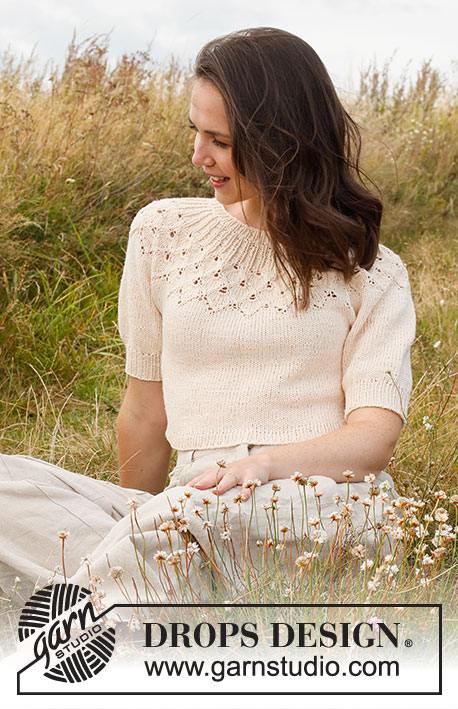
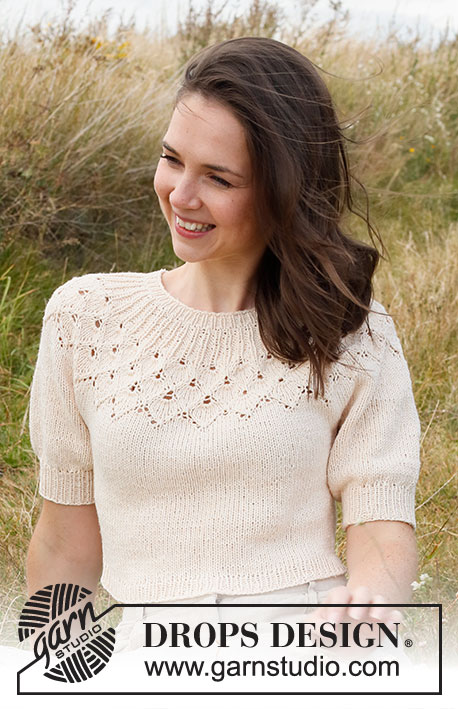


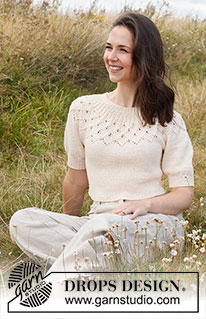

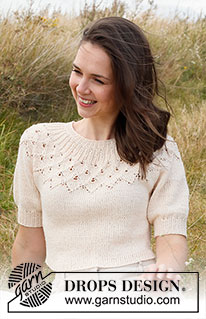
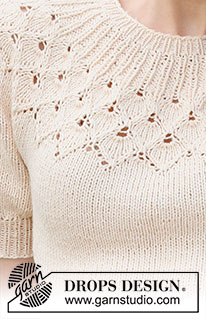


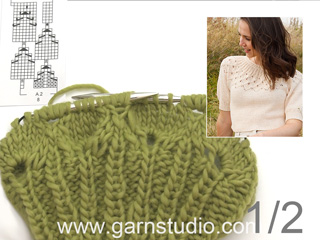
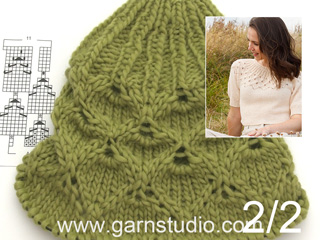


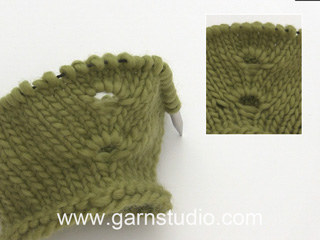



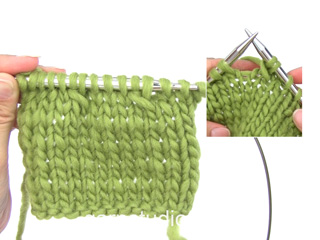












































Comments / Questions (84)
Hej, jeg strikker i str. L. og færdig med mønsteret, men som , men som Irene Jerløv skriver, så ligner det ikke det på billedet. Jeg skulle have 312 m. men havde 370. Så jeg har trævlet det hele op. MVH Fjola
07.06.2021 - 12:54DROPS Design answered:
Hej Fjola, du starter med 104 masker (4m x 26), tager 4 masker ud ifølge A.1 (4m x 26) = 208. Slutter med 12 masker når du er klar med A.2L (12m x 26) = 312 masker. Husk at du tager 6 masker ud ved stjernen i str L :)
07.06.2021 - 14:31Jeg kan ikke få mønstret A2 i 222-32 til at passe. Jeg strikker str XL. Mønster tegningen ligner slet ikke slet ikke bluse mønstret, når jeg forstørrer det, håber at få hjælp hurtigst muligt. Mvh Irene Jerløv
06.06.2021 - 23:12DROPS Design answered:
Hej Irene, Det er svært at sige hvor det går galt for dig... Du følger diagram A.2-XL, starter med de 8 masker nederst i diagrammet og strikker hver pind og følger diagrammet opad. På 3.pind tager du 8 masker ud ved stjernen, hver gang du gentager diagrammet. På 5., 7. og 9. pind tager du 2 masker ind for hver gang du gentager diagrammet. På 11.pind tager du 8 masker ud igen, hver gang du kommer til stjernen og samtidigt tager du 2 masker ind i samme rapport. Vi har set mange af denne model på Ravelry. Sig til hvis det er en speciel pind i diagrammet du vil have forklaret. :)
07.06.2021 - 13:36Hej, jeg tror der er mange fejl i denne opskrift på blusen, både i opskrift og diagram. da jeg var færdig med mønsteret endte jeg med at have 70 m. mere end der står i opskriften????? MVH Fjola
06.06.2021 - 11:25DROPS Design answered:
Hej Fjola, Vi vil gerne hjælpe dig. Hvilken størrelse strikker du? Hvor er du i opskriften? Hvor mange masker skal du have ifølge opskriften?
07.06.2021 - 12:14Eg forstår ikkje A2 str M. Korleis skal eg følge dei ulike diagramma, rekkefølge.
05.06.2021 - 21:45DROPS Design answered:
Hej Kari, A.2M første og anden pind strikkes således: 3 vrang, 1 ret, 3 vrang, 1 ret (gentag disse 8 m pinden ud). 3.pind strikkes således: tag 1 m løst af, 1 ret, løft den løse over, 1vrang, 1 ret, 1 vrang, 2 ret sammen, strik 7 masker i den med stjernen (se diagramforklaringen) gentag disse 8 masker pinden ud. 4.pind: nu har du 12 masker som strikkes således: 1 ret, 1 vrang, 1 ret, 1 vrang, 8 ret, gentag disse 12 masker pinden ud. God fornøjelse!
07.06.2021 - 14:18Mihin on kadonneet pitsineuleen kaaviot A1ja A2 suomenkieliseltä sivulta? Ehdin jo yhden paidan neuloa ja aloitin toista, mutta kaarrokkeen kuvalliset ohjeet eivät näy enää?
05.06.2021 - 20:24Hej, jeg forstår ikke Diagrammet i denne bluse, Diagram A2. jeg syntes den virker mystisk. Håber i kan hjælpe mig MVH Fjola
04.06.2021 - 21:26DROPS Design answered:
Hej, Vi behøver mere information for at vi skal kunne hjælpe dig. Hvilken størrelse? Hvilken pind i A2 synes du er mystisk....?
07.06.2021 - 12:17Beschrijving LIJF "Minder zo iedere 2 cm 4-4-4-5-5 keer in totaal enz " Moet dat niet zijn iedere 3 cm? Dat komt beter uit met de lengte va het lijf
03.06.2021 - 14:14DROPS Design answered:
Dag Jopie,
Nee, want het is denk ik de bedoeling dat je ongeveer op taillehoogte alle minderingen hebt gedaan. Natuurlijk ben je vrij om dat aan te passen zodat de minderingen over de hoogte van het lijf verdeeld zijn.
05.06.2021 - 09:26Ohjeen kauluksen resori ei vastaa kuvassa olevaa. Ohjeessa neuvotaan neulomaan 1n1o, mutta pitäisi tehdä 1o1n, jotta jälki olisi samanlaista kuin kuvassa olevassa paidassa. Myöskään kaavat A1 ja A2 eivät näy suomenkielisellä sivulla.
01.06.2021 - 11:38There are two segments of the graph showing a dark star. As you decrease you need to increase in order not to loose any stitches. Well, in your graph only the second black star segment is showing this. The one previous is not and that is where I'm loosing so many stitches. Please update your graph.
26.05.2021 - 17:27Regarding your last reply: I understand clearly what you are saying and how you obtained the # of stitches. I Started A2 with the 280 stitches required. The problem I clearly see is that where the graph shows the dark star, you cannot reduce stitches without replacing them; only the last segment where there is a dark star is showing this. I have taken all my stitches down to the beginning of the A2 chart and increase as decrease in the sections with the black star. Graph needs fixing.
26.05.2021 - 17:24DROPS Design answered:
Dear Mrs Chelin, I just worked 2 repeats of this diagram in your size and it worked increasing from 10 to 14 sts. In A.2 you will decrease a total of 32 sts (4 leaves) where 8 of these decreases are compensated with yarn overs (last leaf in height, 2nd part of A.2) and increase: 3 white stars x 8 sts = 24 sts + 2 black stars x 2 sts = 10-32+8+24+4=14 sts.
27.05.2021 - 09:18